Gienah, Gamma Corvi (γ Crv), is the primary component of a binary star system located in the constellation Corvus. With an apparent magnitude of 2.585, it is the brightest star in Corvus. It lies at a distance of 154 light years from Earth.
Star system
The Gamma Corvi star system consists of Gamma Corvi A, a blue giant of the spectral type B8 III, and a fainter, less massive companion of the spectral type K5 V – M5 V.
Gamma Corvi A, formally named Gienah, has a mass of about 4.2 solar masses and is 331 times more luminous than the Sun. It has a projected rotational velocity of 30 km/s. The star’s estimated age is about 160 million years, or in the range from 130 to 200 million years.
The companion, Gamma Corvi B, is an orange (K) or red (M) dwarf star with a mass of 0.8 solar masses. It is believed to be orbiting the primary component with a period of 158 years at a distance of about 50 astronomical units.
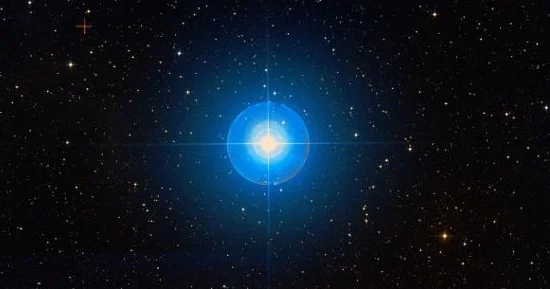
Gienah (Gamma Corvi), image: Wikisky
Gienah is a mercury-manganese star, a chemically peculiar star whose spectrum shows an unusually high abundance of mercury and manganese. Mercury-manganese stars typically have surface temperatures between 10,000 K and 15,000 K and are relatively slow spinners. As a result, they have calm atmospheres. Other bright mercury-manganese stars include Alpheratz in the constellation Andromeda, Maia in the Pleiades cluster in Taurus, Elnath in Taurus, and Muliphein in Canis Major.
The spectrum of Gienah also displays an overabundance of other elements, including beryllium, boron, calcium, phosphorus, titanium, copper, zinc, gallium and yttrium.
Facts
Gienah is part of an asterism known as Spica’s Spanker. Named after a kind of sail, the asterism is formed by the brightest stars of Corvus: Gienah, Algorab, Kraz, and Minkar. A line extended from Gienah through Algorab points the way to the bright Spica in Virgo.
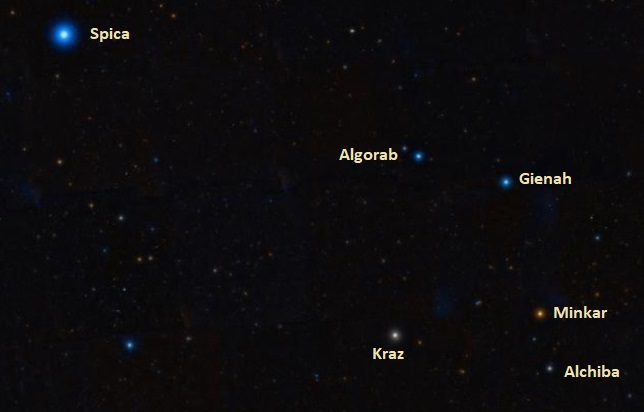
Spica’s Spanker, image: Wikisky
Gienah is one of the 58 bright stars selected for use in navigation. It is the only navigational star in Corvus. It belongs to a group of 13 equatorial navigational stars of the western celestial hemisphere. Other stars in this group are Rasalhague and Sabik in the constellation Ophiuchus, Arcturus in Boötes, Nunki in Sagittarius, Antares in Scorpius, Spica in Virgo, Fomalhaut in Piscis Austrinus, Altair in Aquila, Enif and Markab in Pegasus, Zubenelgenubi in Libra, and Alphecca in Corona Borealis. Due to their position within 30° of the equator, these stars are visible from most places on Earth for at least a part of the year.
With an apparent magnitude of 2.585, Gienah is the 100th brightest star in the sky. It is only slightly fainter than Zosma in the constellation Leo and about as bright as Acrab in Scorpius, Arneb in Lepus, and Delta Centauri in Centaurus. It just outshines Ascella in Sagittarius, Zubeneschamali in Libra, Unukalhai in Serpens, and Sheratan in Aries.
Name
The star’s traditional name, Gienah (pronunciation: /ˈdʒiːnə/), is derived from the Arabic al-janāħ al-ghirāb al-yaman, meaning “the right wing of the crow.” The name itself means “wing.” It refers to the star’s position in the constellation Corvus, marking the left (not right) wing of the celestial crow on modern star charts.
The name was approved by the International Astronomical Union’s (IAU) Working Group on Star Names (WGSN) on November 6, 2016. It formally applies only to the component Gamma Corvi A.
Gamma Corvi traditionally shared the name Gienah with Epsilon Cygni, the star marking the right wing of Cygnus, the Swan. The two stars were known as Gienah Corvi (or Gienah Ghurab) and Gienah Cygni. Epsilon Cygni is now formally known by the name Aljanah, which has the same etymology as Gienah.
The name Gienah appeared in the 17th century Egyptian astronomer Al Achsasi Al Mouakket’s Calendarium as Al-janāħ al-ghirāb al-yaman. It was later translated into Latin as Dextra ala Corvi, “the right wing of the raven.”
The Chinese know Gienah as 軫宿一 (Zhěn Sù yī), the First Star of Chariot. The Chinese Chariot asterism is formed by Gienah with Minkar, Algorab and Kraz. It corresponds to Spica’s Spanker. In Chinese astronomy, the asterism is one of the southern mansions of the Vermilion Bird.
Location
Gienah is relatively easy to find because it is located near Spica, the 16th brightest star in the sky, and because it is part of a conspicuous asterism, Spica’s Spanker. The stars that form the asterism are not exceptionally bright, but they lie in a relatively faint area of the sky and are easy to make out on a clear, dark night. Gienah lies at the northwest (top right) vertex of the Spanker.
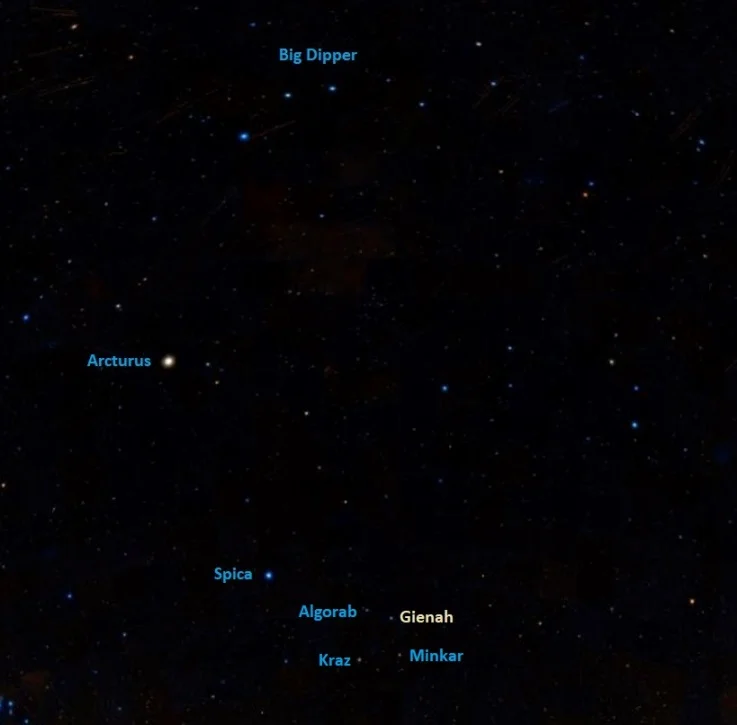
Gienah location, image: Wikisky
Even though Gienah and Algorab serve as pointer stars to Spica, it is easier to use the much brighter Spica to find the stars of the Spanker. Spica is found along the imaginary curved line extended from the three stars of the Big Dipper’s handle: Alkaid, Mizar and Alioth. Arcturus is the first exceptionally bright star along the line and Spica is the second.
Gienah can be used to find several relatively bright deep sky objects that lie in the vicinity. The planetary nebula NGC 4361 appears southeast of the star. It has an apparent magnitude of 10.9 and lies 3,350.4 light years away. It occupies an area 1.3’ by 1.3’ in size.
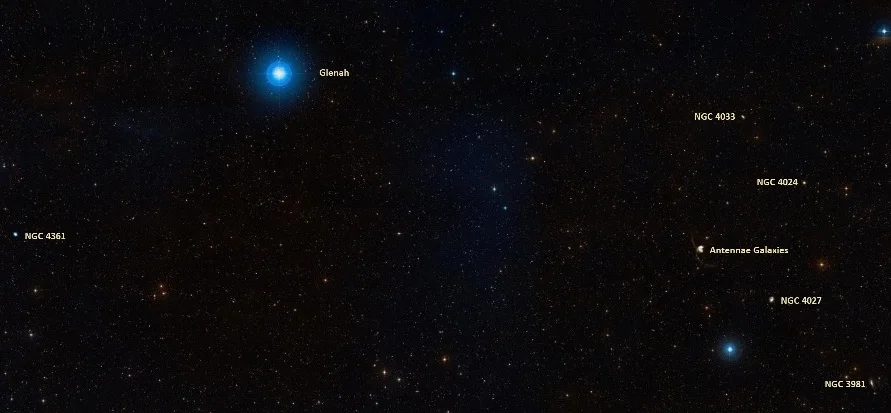
Gienah, NGC 4361, NGC 4038, NGC 4039, NGC 4027 and NGC 3981, image: Wikisky
The elliptical galaxy NGC 4033 lies west of Gienah and the galaxy NGC 4024 (type E/SB0) appears southwest of NGC 4033. Both galaxies have apparent magnitudes of 11.7.
The famous Antennae Galaxies (NGC 4038 and NGC 4039) lie in the same area. They have visual magnitudes of 11.2 and 11.1 and lie 45 and 65 million light years away. NGC 4038 is the central galaxy in the NGC 4038 Group, which also includes NGC 4024, NGC 4033, the barred spiral galaxy NGC 4027, and the spiral galaxy NGC 3981. NGC 4027 and NGC 3981 have apparent magnitudes of 11.7 and 11.75.
Constellation
Gienah is located in the constellation Corvus. Representing the celestial raven or crow, Corvus is one of the smaller constellations, the 70th in size out of 88. It occupies 184 square degrees of the southern sky. Associated with the sacred bird of Apollo, Corvus is one of the 48 Greek constellations, first catalogued by the Greek astronomer Claudius Ptolemy in his Almagest in the 2nd century CE.
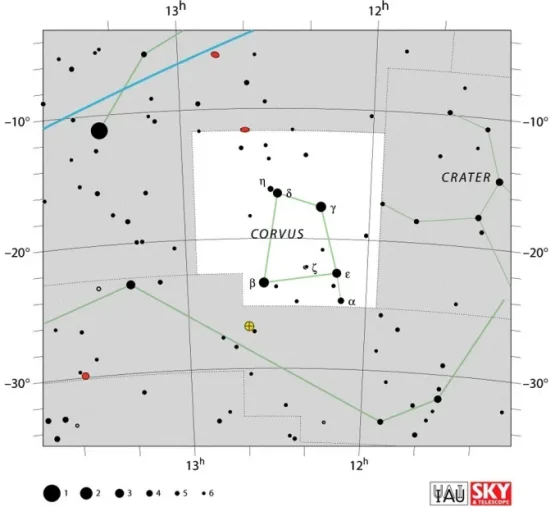
Corvus constellation map by IAU and Sky&Telescope magazine
Recognizable for the distinctive quadrilateral asterism formed by its brightest stars, Corvus lies between the larger constellations Virgo, Hydra and Crater. It contains 29 visible stars (brighter than magnitude 6.5), but only three stars brighter than magnitude 3.00: Gienah, Kraz and Algorab.
The best-known deep sky objects in Corvus are the Antennae Galaxies, a famous interacting pair that shows a likely future of the Milky Way and Andromeda when they begin to merge, and the bright planetary nebula NGC 4361.
The best time of year to observe the stars and deep sky objects in Corvus is during the month of May, when the constellation rises high in the evening sky. The entire constellation is visible from locations between the latitudes 60° N and 90° S.
The 10 brightest stars in Corvus are Gienah (Gamma Crv, mag. 2.585), Kraz (Beta Crv, mag. 2.647), Algorab (Delta Crv, mag. 2.962), Epsilon Corvi (mag. 3.024), Alchiba (Alpha Crv, mag. 4.03), Eta Corvi (mag. 4.29 – 4.32), HD 107418 (mag. 5.14), VV Corvi (mag. 5.19 – 5-34), TY Corvi (31 Crt, mag. 5.19 – 5.23), and Zeta Corvi (mag. 5.21).
Gienah – Gamma Corvi
| Spectral class | B8 III |
| U-B colour index | –0.344 |
| B-V colour index | –0.111 |
| Apparent magnitude | 2.585 |
| Absolute magnitude | -0.79 |
| Distance | 154 ± 1 light years (47.1 ± 0.4 parsecs) |
| Parallax | 21.23 ± 0.20 mas |
| Radial velocity | -4.2 km/s |
| Proper motion | RA: –158.61 ± 0.15 mas/yr |
| Dec.: +21.86 ± 0.10 mas/yr | |
| Mass (γ Crv A, γ Crv B) | 4.2 M☉ (3.9 – 4.6 M☉), 0.8 M☉ |
| Luminosity (γ Crv A) | 331 L☉ |
| Age (γ Crv A) | 160 million years (130 – 200 million years) |
| Rotational velocity (γ Crv A) | 30 km/s |
| Constellation | Corvus |
| Right ascension | 12h 15m 48.37081s |
| Declination | –17° 32′ 30.9496″ |
| Names and designations | Gienah, Gamma Corvi, γ Crv, 4 Corvi, HD 106625, HR 4662, HIP 59803, FK5 457, SAO 157176, BD–16 3424, ALS 15805, GC 16740, GCRV 7338, IRAS 12132-1715, 2MASS J12154839-1732310, JP11 2195, NSV 5515, PMC 90-93 326, PPM 225593, UBV 11010, TYC 6098-1754-1 |